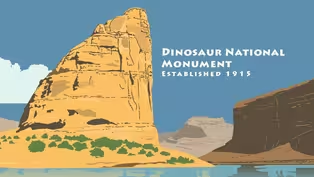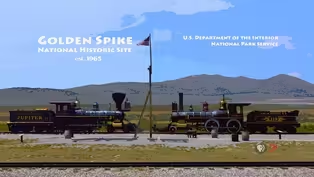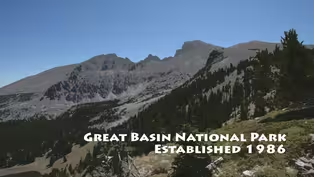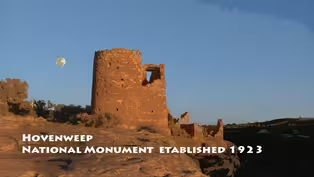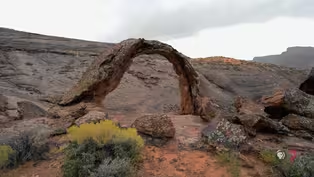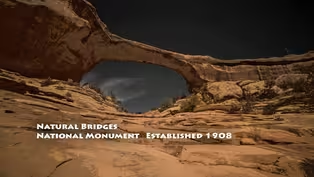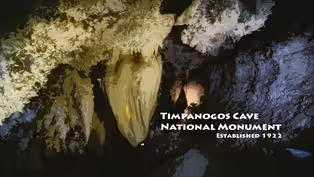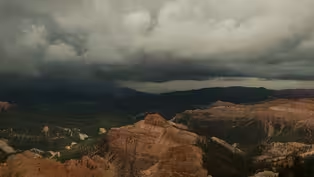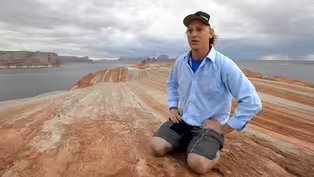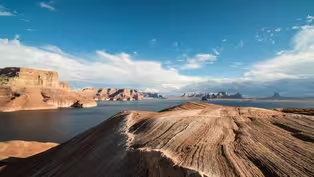
Cedar Breaks National Monument
Clip: Special | 7m 8sVideo has Closed Captions
Cedar Breaks National Monument features geology, forests & meadows at 10,000 feet.
Cedar Breaks National Monument features spectacular geology, forests and meadows at 10,000 feet. The half-mile deep amphitheater of eroding limestone, shale, and sandstone is vibrant with hues from white to yellow to purple and brilliant orange. The park’s altitude and lack of light pollution make for great night sky viewing, while sub-alpine meadows provide spectacular wildflower gazing.
Problems playing video? | Closed Captioning Feedback
Problems playing video? | Closed Captioning Feedback
National Parks - Beyond the Crowds is a local public television program presented by PBS Utah

Cedar Breaks National Monument
Clip: Special | 7m 8sVideo has Closed Captions
Cedar Breaks National Monument features spectacular geology, forests and meadows at 10,000 feet. The half-mile deep amphitheater of eroding limestone, shale, and sandstone is vibrant with hues from white to yellow to purple and brilliant orange. The park’s altitude and lack of light pollution make for great night sky viewing, while sub-alpine meadows provide spectacular wildflower gazing.
Problems playing video? | Closed Captioning Feedback
How to Watch National Parks - Beyond the Crowds
National Parks - Beyond the Crowds is available to stream on pbs.org and the free PBS App, available on iPhone, Apple TV, Android TV, Android smartphones, Amazon Fire TV, Amazon Fire Tablet, Roku, Samsung Smart TV, and Vizio.
- [Narrator] We resume our tour at Cedar Breaks, which is only a short distance off the highway that leads from Zion to Bryce.
Here the altitude is nearly 11,000 feet and sometimes the snow has not yet left, even in early June.
More vividly colored than Bryce Canyon, which it resembles somewhat, Cedar Breaks contains more than 50 hues of color that have been counted.
How many more exist under the shifting play of light and shadow, no one knows.
We are greatly impressed and promise ourselves that we will come back again sometime.
(upbeat music) - I was probably six, seven years old the first time I actually came up to Cedar Breaks that I can remember, looked at the amphitheater and, you know, hiked on some of the trails.
I'm Ranger Dave Sorenson, or the Dark Ranger, and some people look at me kind of weird when I say the Dark Ranger, but they call me the Dark Ranger because I conduct all the star parties up here at Cedar Breaks National Monument.
And we're way high.
They're obviously a lot of fun, so we actually have one tonight.
Hopefully it's going to be clear.
As you can see, it's kind of cloudy right now, but it's supposed to clear off, so we're gonna hope for the best.
(soft music) It's always been a really amazing place.
The wildlife is just amazing up here, the wildflowers.
We just had our wildflower festival this year and we still have some of 'em in bloom.
The plant life up here, the hikes, the amphitheater, the geology behind this place is just amazing.
About 30 million years ago, there was a lake here that existed, and it was here for about 20 million years and covered this whole area.
Well, 10 million years ago, we had a fault line become active, started pushing this area up the valley below started dropping, the lake dried up, and you're left with a dry lake bed.
Well, all that rich iron that was deposited into the lake bed all those years started to react with the elements in the air.
And what does iron do when it reacts with the elements of the air?
It starts to rust.
So that's why you have all the rich colors of orange and red and yellow comes from all that iron oxidation that's present in the soil and in the rocks.
It was deposited back when the lake was here.
- In general, one sees the breadth of it, I think, but artists help you see the beauty in the details.
I'm Valerie Orlemann.
I am a landscape painter.
I am looking for detail, for something to focus on, something beautiful.
You know, the tree on the edge, a beautiful form out there in all that faceted, you know, erosion, a beautiful form, a beautiful light, a beautiful color.
Something to say, look at this, look at this.
(soft music) It is worth spending time.
An awful lot of what I saw was that people drive, drive, drive, viewpoint, stop, look both ways, get back in your car, drive.
And there's something to be said for that.
You can see a lot.
But I would also say it is wonderful to get out and walk and spend time with the wind and the trees and the changing light and the fabulous smell of high altitude woods, and the view just to spend time watching it change because it does change just in the few minutes that you watch it, it'll be different.
(soft music) (thunder rumbles) Why do I love it?
Oh my gosh, it's the scale, the fabulous erosional detail, the rock solid beauty in the sunset light.
I don't know, it lifts my heart, it just brings me joy.
- [Narrator] Cedar Breaks National Monument in southwestern Utah, easily reached by fine highways, is a spectacle that well repays motoring vacationing.
- I like to refer to it as kind of a hidden gem because we get a lot of visitors that are on their way to Zion National Park or the Grand Canyon, or over to Bryce Canyon, and they just end up stumbling across this place by seeing one of the road signs, or they end up talking to one of the locals and they get up here and they're just like, "Whoa, this is cool!
"I didn't even know this place was on the map "or even existed!"
(upbeat music) But I would've to say the night sky is probably my favorite aspect of Cedar Breaks.
Saturn, where are you?
It'll be right over here.
Tonight is actually marks the peak night of the Perseus meteor shower, and we're actually having a special star party for that.
We're likely gonna see some meteors tonight.
- We're so excited, and for two weeks we've been watching the weather and it was gonna be cloudy and thunder storming, and we thought, oh, there goes our Wednesday night.
So we've been planning this for a while, so this is pretty cool.
This is the highest I've ever been in my life.
(woman laughing) - It's really awesome to observe the night sky up at this elevation with the kind of darkness that we have up here at Cedar Breaks National Monument.
We're at 10,350 feet and so we're above a lot of the pollution and the bad air quality that seems to linger down below in the valleys and stuff.
Being away from cities and light pollution and things, it's really dark up here.
And so darkness is a key factor in observing the night sky.
And so up here you get to see everything and the Milky Way just comes to life up here when it gets dark, even just with a naked eye.
(upbeat music) The National Park Service as a whole, as well as us here at Cedar Breaks National Monument are really all about preserving the night sky and keeping our skies dark.
You have to think about the animals and the wildlife and the things that need the darkness of night in order to survive.
Because if we get too much light pollution around and things get lit up too much, you're gonna end up changing the lifecycle, the lifestyle of a lot of animals, a lot of plant life.
And that can lead to even extinction, in some cases.
All the meteors that we're gonna see is gonna originate from the Constellation Perseus, which is gonna be right over here in the northern sky.
Having the star parties is one of the funnest parts of my job up here.
People look through the telescope and they just, you get everything from, "Whoa, that is the coolest thing I've ever seen," to, "That is so cool, that looks fake.
"It looks like a picture.
It looks so good."
So that's what makes Cedar Breaks just a great place to observe the night sky throughout the year.
I mean, not just the summer, but the wintertime too.
Video has Closed Captions
Clip: Special | 9m 17s | Whether it's dinosaurs or western settlement, Dinosaur has something to interest you. (9m 17s)
Video has Closed Captions
Clip: Special | 8m 35s | The park ranges over 1.25 Million acres of pristine red rock and mountain landscapes. (8m 35s)
Golden Spike National Historic Park
Video has Closed Captions
Clip: Special | 4m 33s | On May 10th 1869 the Transcontinental railroad was completed in Utah. (4m 33s)
Video has Closed Captions
Clip: Special | 6m 52s | Underneath part of the Park is Lehman Cave extending a quarter-mile into the limestone. (6m 52s)
Video has Closed Captions
Clip: Special | 3m 16s | Hovenweep includes six prehistoric villages built between A.D. 1200 and 1300. (3m 16s)
National Parks - Beyond The Crowds: Producer Profile
Clip: Special | 3m 14s | Producers Nancy Green and Joe Prokop talk about the making of Beyond the Crowds. (3m 14s)
Natural Bridges National Monument
Video has Closed Captions
Clip: Special | 4m 25s | In 1908, Natural Bridges became Utah’s first National Monument. (4m 25s)
Timpanogos Cave National Monument
Video has Closed Captions
Clip: Special | 4m 51s | The peaks and valleys of Mt. Timpanogos allows for much more than just a simple cave tour. (4m 51s)
Panning Timelapse at Cedar Breaks National Monument
Clip: Special | 13s | This high altitude gem features spectacular geology, forests and meadows at 10,000 feet. (13s)
Weathering Pit Ridge on Lake Powell
Video has Closed Captions
Clip: Special | 1m 49s | Inside Glen Canyon National Recreation Area deep pits and holes were formed. (1m 49s)
National Parks: Beyond the Crowds - Preview
Preview: Special | 30s | KUED provides an eye-opening introduction to remote adventure destinations. (30s)
Providing Support for PBS.org
Learn Moreabout PBS online sponsorship
- Science and Nature

Explore scientific discoveries on television's most acclaimed science documentary series.

- Science and Nature

Capturing the splendor of the natural world, from the African plains to the Antarctic ice.












Support for PBS provided by:
National Parks - Beyond the Crowds is a local public television program presented by PBS Utah
